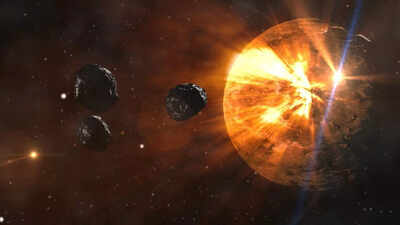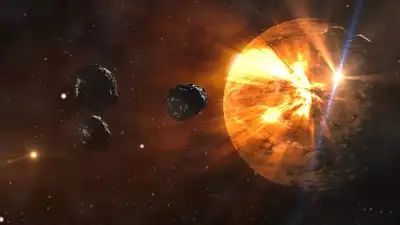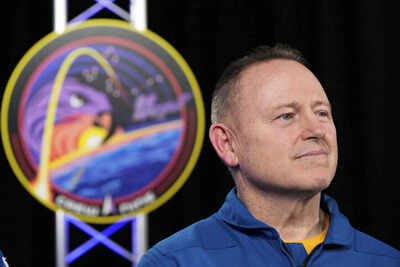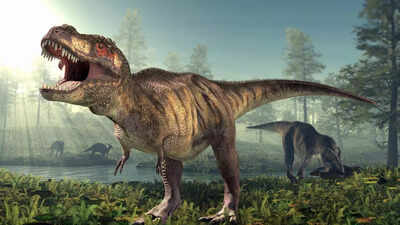NASA has issued an important alert about two large asteroids set to pass close to Earth on Friday, August 8, 2025. While there is no immediate danger, the significant size, high speed, and timing of these space rocks have drawn widespread attention from astronomers, scientists, and the public. The first asteroid, (2025 OJ1), measures approximately 300 feet wide—about the height of a 30-story building—and will pass at a distance of around 3.2 million miles. The second, (2019 CO1), roughly 200 feet wide, will fly by at about 4.24 million miles. NASA’s advanced monitoring systems continuously track such near-Earth objects, ensuring timely updates. These close approaches highlight the importance of ongoing vigilance in planetary defense and space observation.
NASA issues urgent warning on two massive asteroids approaching Earth on August 8, 2025
Asteroid (2025 OJ1): Size, speed, and distance revealed
The first asteroid, officially designated (2025 OJ1), is approximately 300 feet (about 91 meters) in diameter—roughly equivalent to the height of a 30-story building. This considerable size makes it one of the larger space rocks observed in recent years.According to NASA’s Near-Earth Object tracking system, (2025 OJ1) will pass Earth at a distance of approximately 3.2 million miles (5.15 million kilometers). While this distance is vast by everyday standards, it is considered a close approach in astronomical terms. To put this in perspective, the average distance between Earth and the Moon is about 238,855 miles (384,400 kilometers), so (2025 OJ1) will pass about 13 times farther than the Moon.Traveling at an extremely high velocity, this asteroid will briefly be visible to powerful telescopes and tracking systems as it speeds through near-Earth space. Its size and proximity make it an object of interest for astronomers studying asteroid compositions, orbital mechanics, and potential impact ascenarios.
Asteroid (2019 CO1) : Size, speed and orbital details
On the very same day, NASA will observe another significant asteroid, (2019 CO1), estimated to be about 200 feet (approximately 61 meters) in diameter. This size is comparable to that of a large commercial airplane, underscoring the considerable mass of this space object.(2019 CO1) will pass Earth at a distance of roughly 4.24 million miles (6.82 million kilometers), which is farther than (2025 OJ1) but still within the category of a close celestial approach. Despite being smaller, the asteroid’s high speed and trajectory make it an important target for continuous observation.The simultaneous close passes of these two asteroids highlight the dynamic environment of near-Earth space and remind us that the solar system is home to countless objects of various sizes moving at incredible speeds.
No risk of collision for Earth; NASA confirms
NASA has been quick to reassure the public that neither (2025 OJ1) nor (2019 CO1) poses any collision threat to Earth during their 2025 flybys. Based on precise orbital calculations and tracking data, scientists confirm that both asteroids will safely pass by without entering Earth’s atmosphere or causing any harm.It is important to understand that close approaches by asteroids happen regularly as part of the natural movement of objects within our solar system. NASA’s advanced technology and early warning systems enable accurate predictions and timely updates, ensuring that potentially hazardous situations are identified well in advance.
What are near-Earth objects (NEOs) and why do they matter
Near-Earth Objects (NEOs) are comets or asteroids that have orbits bringing them into close proximity with Earth. Because some of these objects can potentially collide with our planet, NASA and other space agencies worldwide actively track and study them. NEOs vary widely in size—from small meteoroids to massive asteroids spanning hundreds of feet in diameter.Monitoring NEOs is crucial for planetary defense because early detection of potentially hazardous objects allows for preparation, possible deflection missions, or evacuation plans if necessary. The two asteroids approaching on August 8, 2025, fall under this category of closely monitored NEOs.
How you can stay updated on near-Earth asteroid events
NASA provides public access to information on near-Earth asteroids through several platforms:
- The Near-Earth Object Web Portal, where users can track upcoming asteroid flybys
- Social media updates from NASA’s Planetary Defense Coordination Office
- Live streams and news releases during notable asteroid approaches
For those interested in astronomy, many organizations and amateur astronomer groups also share observational tips and updates during asteroid flybys.
NASA’s ongoing vigilance safeguards Earth from asteroid threats
On August 8, 2025, the close approach of two large asteroids, (2025 OJ1) and (2019 CO1), reminds us of the dynamic and sometimes unpredictable nature of near-Earth space. Despite their massive size and high speed, both will pass safely millions of miles away, presenting no immediate threat to our planet.Thanks to NASA’s continuous monitoring, advanced technology, and the dedicated work of the Planetary Defense Coordination Office, Earth remains well-protected from potential asteroid hazards. These events emphasise the importance of sustained investment in space observation and planetary defense initiatives as humanity looks toward a safer future in space.Also Read | Perseid meteor shower 2025 to peak on August 12–13: When and where to watch the dazzling fireball display






